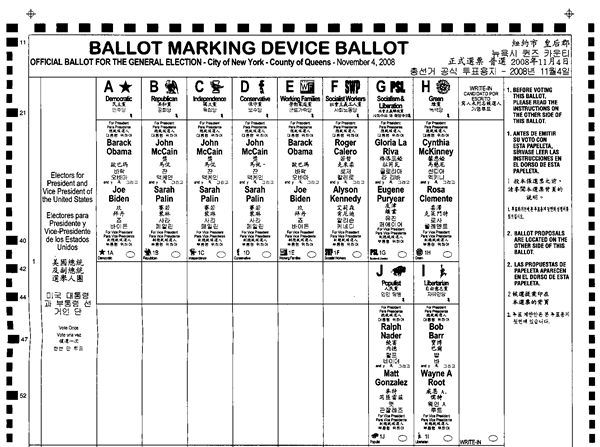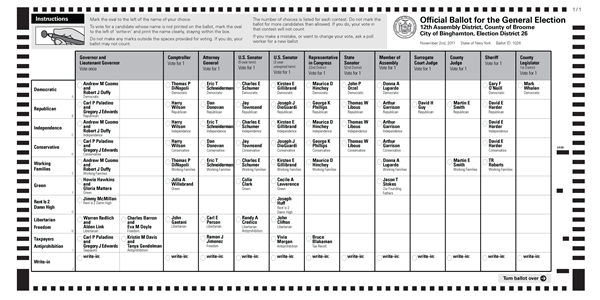The business of trying to design better elections has it’s ups and downs. What’s going on in New York State is a good example.
Good news. In 2010, New York State switched from lever machines to paper ballots.
Bad news. The ballots were, to put it mildly, difficult to read. When we saw the ballot design, we were shocked. It was cluttered, confusing, and hard to read. Requirements for multiple languages made the situation even worse in New York City.

We weren’t the only ones worried about the impact of the ballot design. The League of Women Voters surveyed over 1000 voters in 47 counties. In their 2010 Election Survey Report. They called fixing usability of the ballot an “immediate priority.”
In their survey, voters told them that:
- The text is hard to read because the font is too small
- It’s difficult to tell where one contest ends and the next one begins
- They had trouble marking their choices in small ovals or squares
- The instructions were missing or incomprehensible
- They were not told about magnifying lenses or other assistance
These are all problems with basic principles of election design, usability, and plain language that have been covered in official guidelines like the Election Assistance Commission’s Effective Designs for the Administration of Federal Elections, and in advocacy reports like the Brennan Center’s Better Ballots.
Why are we seeing such basic design probems? One reason is state election law. The basic layout and contents of the ballot – including the exact words of the instructions – are written in the law. Yep. In law.
Good news. Laws can be changed. Assemblyman Brian Kavanagh introduced the Voter Friendly Ballot Act in May 2011 (that’s over a year ago). Usability in Civic Life and AIGA worked with the Brennan Center to create sample ballots showing what the new bill would make possible.

The changes in the law would allow changes in the design to make the ballot easier to read and use:
- Larger text for candidate names, titles, and instructions
- Shorter, clearer instructions, placed where they will be read
- Emphasizing the candidates names with bold text and less clutter
- Ovals next to the names, making a clearer association
- Better divisions between contests, using better lines and clear shading
The bill also allows just two languages on a ballot, keeping the ballot clear and readable.
Bad news. We had high hopes, especially when NY Times reported that a “deal was near.” The bill got part of the way through the legislative process. It passed in the Assembly on Jun 21, the last day of the session, but did not even come up for a vote in the State Senate.
Those changes to design a better ballot for New York? They won’t happen.
Even more bad news. The next opportunity to pass the Voter Friendly Ballot Act will be after the November 2012 election.
All of this leaves us scratching our heads. This is such a basic, clear problem. Is it really not going to be fixed for the next election?
While we are waiting for the Voter Friendly Ballot Act to pass, we’re going to be looking carefully to see what changes could be made, even under the current law, so that New Yorkers get to vote on ballots that give voters confidence that their votes will be cast as they intend.
Credit for the ballot redesign work goes to Drew Davies and the team at Oxide Design Co. who created version after version, keeping up with changes in the draft bill. We also want to thank the Brennan Center for the opportunity to work with them on this issue.
